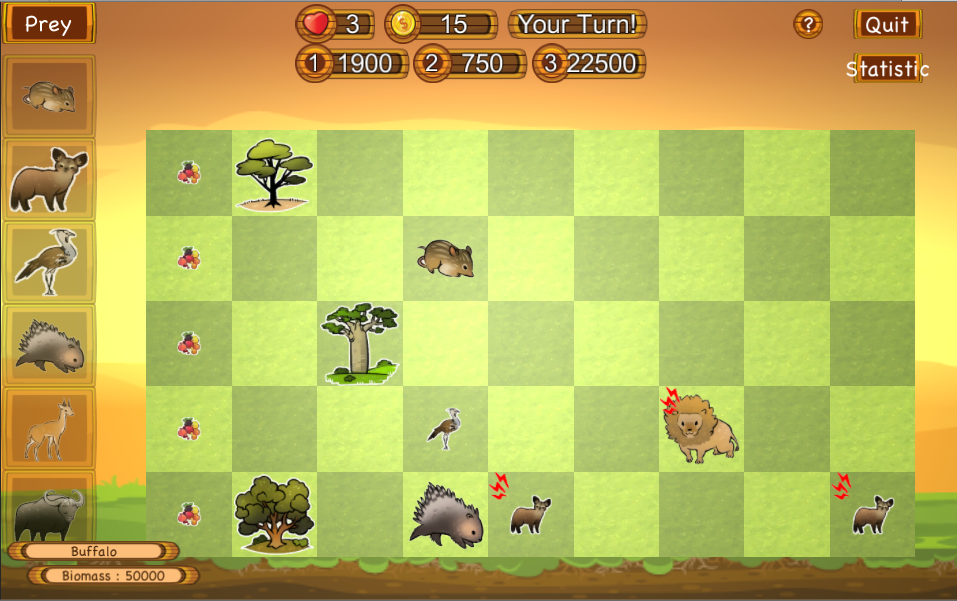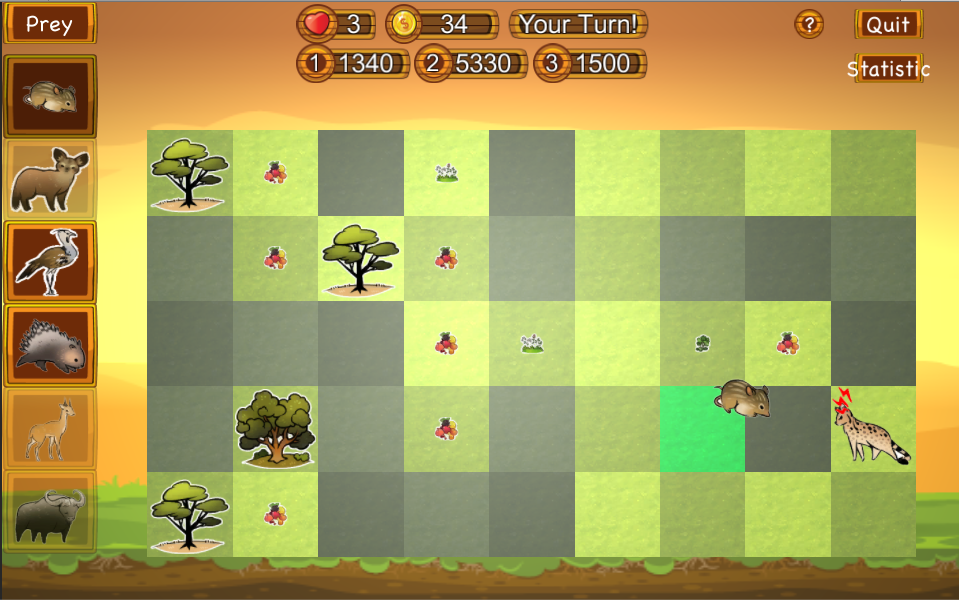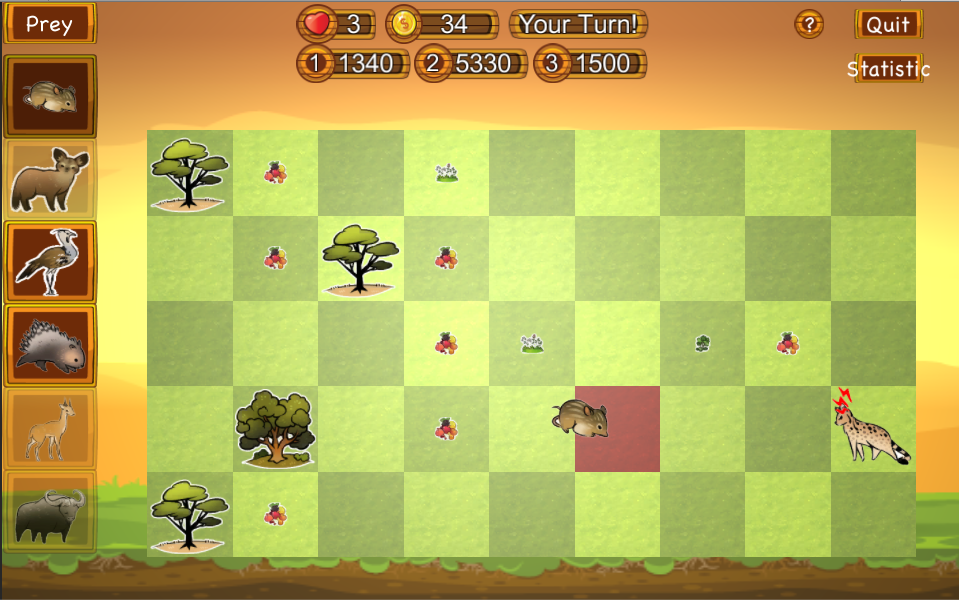How to Play Don't Eat Me!
Watch Demonstration Video!
Introduction
Unlike some other games on World of Balance, Don't Eat Me is a single player game. There is no option for multi-player mode. The design and influence of Don't Eat Me was inspired by the popular and extremely fun tower defense game "Plants vs. Zombie", but with a cute educational animal spin to it.
The goal of the game is to educate players on the relationship of resources and consumers in the animal kingdom. The player can choose from a set group of plants and prey species to counter against enemy predators. The goal is to be able to efficiently choose the correct plants to support the correct prey to counter oncoming predator enemies. Since each species has a set amount of biomass, strategic game play is very important as to not waste resources. Each successful countering of the enemy predators will earn the player a credit which can be used for World of Balance Lobby.
Game Rules
Overview
Predators will periodically spawn at the right of the screen. Predators will advance a tile left during their turn. Once a predator crosses the entire board, the player will lose a life. When the player loses all three lives, the game will end. Every predator will have a preference towards certain prey. If the predator eats the correct prey the predator will leave the board and one credit will be awarded to the player. However, if the predator eats a plant or incorrect prey, the predator will stay on the board and no credits will be awarded. Players will have to place plants and prey on the board to satiate the predators' hunger and earn as many credits as possible!

Game Board
Don't Eat Me features a 9x5 tile grid. The player can place either plants and prey on the board. However plants must be placed first on the gaming grid before any prey and be placed. Plants can be placed on any unoccupied tile - with the exception of the last most right column. Prey can only be placed when there is enough biomass. Plants decide which tiles a prey can be placed on. Each plant has a certain range of tiles that prey can be placed on (more information below). Plants with more biomass will have a smaller title range for prey placement and plants with less biomass has a larger range.
Turn System
Don't Eat Me features a turn based system. Turn's alternate between the player and the enemy predator spaning. The player may only place plants or prey on the game board when it is their turn. When it is the predator's turn all predators that are currently on the game board will advance one tile to the left. Periodically a new predator will spawn at the end of the game board.
Biomass Tiers

Don't Eat Me features a three-tiered biomass system. The first tier (T1) displays the current biomass available to plants. T1 limits the amount of plants the player can place on the game board. If a plant is placed on the board, the biomass of the plant is subtracted from the T1 total. If a plant is consumed by a predator, the biomass is restored. The second tier (T2) displays the current biomass available to prey. T2 limits the amount of prey the player can place on the board. Once a plant is placed on the board half of the plant's biomass value is added to the T2 total. The T2 total starts off at zero to force players to place a plant on the board first. If a prey is consumed by a predator that favors that prey, the biomass is restored. The third tier (T3) displays the total predator biomass on the board. When a predator spawns, the biomass of the predator is added to the T3 total. Once a predator eats the correct prey and leaves the board, the biomass is subtracted from the T3 total.
Food Chain
Don't Eat Me implements a simplified food chain. While predators will eat any type of plant or prey, their hunger won't be satiated (they won't leave the game board) until they eat a specific prey. Credits also won't be awarded unless the predator eats a preferred prey. See below for the predator preferences.
Featured Species
Plants
Below are the playable plants in Don't Eat Me. Plants can be placed anywhere on the grid except for the most right column. Each plant has a specific area in which it can support and make a prey playable on the grid. Each plant also has a set amount of biomass which is needed to support the prey on the grid. If there are not enough biomass for a certain prey it cannot be placed on the grid. The dark green highlighted tile on the game grid depicts where a plant can placed, the red highlighted tile depicts where a prey can be played if there are enough biomass accumlated by the plants.
| Species | Biomass | Image | Playable Field |
| Fruits and Nectar | Biomass: 20 |  |
 |
| Grass and Herbs | Biomass: 40 |  |
 |
| Trees and Shrubs | Biomass: 40 |  |
 |
| Acacia | Biomass: 2,400 |  |
|
| Big Tree | Biomass: 3,200 |  |
|
| Baobab | Biomass: 4,400 |  |
Prey
As mentioned above, there needs to be two conditions present for a prey to be made playable on the grid. The player needs to have accumlated enough biomass as shown in Tier 2/Level 2 of the available biomass and have the correct plants giving the prey a tile to be placed. Below are the prey that a player can play in game and the biomass needed of each prey. Also just like the plants, to show a player where a prey can be placed on the game grid, a dark green tile hightlight will be displayed if a prey can be placed on certain tile that the player is hovering over with the selected prey.
| If tile is hightlighted in dark green, the prey can be placed on the tile. The tiles highlighted in grey are other tiles that the player can place the prey on. |  |
| If tile is highlighted in red, the prey cannot be placed on that tile. |  |
| Species | Biomass | Image |
| Tree Mouse | Biomass: 800 | |
| Crested Porcupine | Biomass: 1,500 | |
| Kori Buskard | Biomass: 2,000 | |
| Bat-Eared Fox Mouse | Biomass: 10,000 | |
| Oribi | Biomass: 25,000 | |
| Buffalo | Biomass: 50,000 |
Predators
Below are the predators that will randomly spawn in the game. In game, all predators will have three little red squiggly lines at the top left corner of a predator tile so the player can easily tell prey and predator apart. The biomass of each prey and what their preferred prey listed.
| Species | Biomass | Image | Likes to Eat |
| African Wild Dog | Biomass: 25,000 |
|
|
| Bat-Eared Fox | Biomass: 10,000 |
|
|
| Black Mamba | Biomass: 8,000 |
|
|
| Leopard | Biomass: 30,000 |
|
|
| Lion | Biomass: 2,500 |
|
|
| Serval Cat | Biomass: 1,500 |
|
CSC 631/831 Multiplayer Game Development Class
